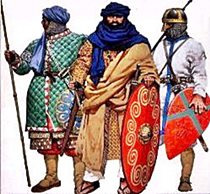
Battle of Altava |
year: 578 |
| The Byzantines dissolved the Mauro-Roman Kingdom of Altava | ★ ★ ★ ★ ★ |
|
enemy: Berbers of Atlava kingdom
|
location: Somewhere in northern Algeria, possibly not far from the ancient city Altava
|
accuracy:
●●●●●
|
|
battle type: Pitched battle |
war: Berber Tribes Rebellions |
modern country:
Algeria |
| ▼ The Byzantines(emperor: Tiverius II) | ▼ The Enemies | |
| Commander: | magister millitum Gennadius | Garmul (Berber king) |
| Forces: | ||
| Losses: |
| Background story: |
| The Mauro-Roman Kingdom, formed in the 5th century, was an independent Christian and Romanized Berber kingdom centered on the city of Altava. It was located in present-day northern Algeria. In 569, the king of Altava Garmul attacked the Byzantine African provinces to the east and killed the governor Theodore. The attacks continued in the next years and two more Byzantine generals were killed: Theoctistus in 570, and Theoctistus' successor Amabilis in 571 (this military activity is not reported by Byzantine sources, only by Johannes of Biclaro, a Visigoth chronicler.) In 578 emperor Tiberius II appointed Gennadius as magister millitum of Africa, while Thomas was appointed governor (praetorian perfect). |
The Battle: |
 Berber warriors We do not know details about the final battle which is again reported only by Johannes of Biclaro. |
Aftermath: |
| After the battle, the Mauro-Roman Kingdom was dissolved and most its territories became part of the Byzantine province and remained so until the Arab conquest. Gennadius in 591 became the first ruler of the Exarchate of Africa. |
|
|
